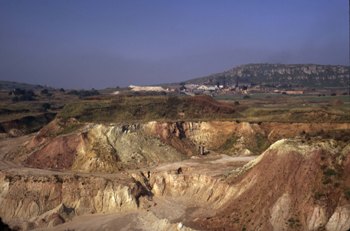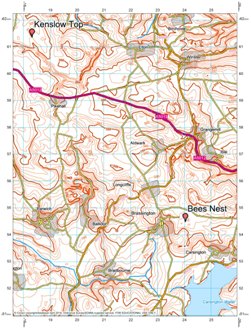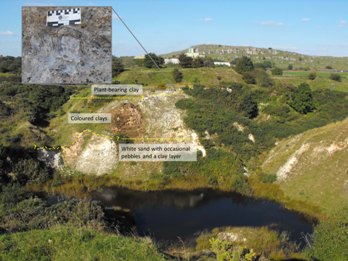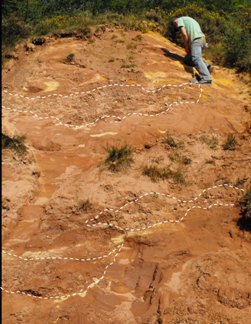Matthew Pound* and James Riding** on a little-known Miocene sedimentary unit in the southern Peak District (Derbyshire)
 The Miocene Epoch (23.0–5.33 Ma) is not one that many geologists would associate with the UK. Despite the extensive distribution of considerable thicknesses of marine Neogene sediments offshore, the onshore record is profoundly sparse.
The Miocene Epoch (23.0–5.33 Ma) is not one that many geologists would associate with the UK. Despite the extensive distribution of considerable thicknesses of marine Neogene sediments offshore, the onshore record is profoundly sparse.
Picture: The Bees Nest Pit
It is well known that there is a major hiatus between the Oligocene and the Pliocene in southeast England. The entire absence of Miocene sediments throughout this region is due to Alpine mountain building and/or glacial erosion during the Quaternary. However, there are terrestrial Miocene strata that you can walk to in the UK.
These deposits are not geographically extensive, and have not received much attention recently. The three best known are the terrestrial sediments of the St Agnes outlier in Cornwall, a dissolution pipe-fill on Anglesey and the alluvial-fluvial-lacustrine Brassington Formation of Derbyshire.
The latter two occurrences survived erosion during the Late Neogene due to their karstic fill nature, and of these the Brassington Formation is by far the more extensive. The evidence suggests good preservation of the Brassington Formation within the karst cavities. The association of the Brassington Formation with glaciogenic sediments may provide useful insights into the Quaternary history of the Peak District.
Picture: Locality map, showing the location of Bees Nest and Kenslow Top Pits.
It seems likely that very little of the Brassington Formation sediments on the surface were eroded during the Devensian glaciation because the glacial limit at that time lay to the north of the outcrop area. However, potentially there was significantly more erosive capacity during earlier stages in the Quaternary.
Variable
The Miocene Brassington Formation of the southern Pennines is a highly variable, fining-upwards siliciclastic succession. It was largely derived from the weathering of Triassic strata, probably during the Early Miocene, and preserved in and around karstic hollows within highly dolomitised Lower Carboniferous limestone. Recent research has allowed us to revise the age of this important unit, and to use these conclusions to assess the uplift of the southern Pennines.
However, during fieldwork we struggled to recognise and correlate the two uppermost members consistently. Preliminary biostratigraphical data based on pollen suggests that at least the uppermost part of the Brassington Formation may be significantly diachronous in the two main outcrop areas.
Named
The Brassington Formation was formally named in the early 1970s and is known from around 60 karstic hollows, many of which were quarried for making refractory bricks. It appears to have been deposited as an extensive sheet of sediment that was initially eroded from the Triassic bedrock to the south of Brassington. This erosion probably occurred during the Early Miocene and, following the recession of the Triassic cover, subsequently denuded the underlying shale-dominated units of the Pennsylvanian (Upper Carboniferous).
 Picture: The Bees Nest pit today, with sediment types annotated.
Picture: The Bees Nest pit today, with sediment types annotated.
There is still some controversy as to whether or not the karstic processes that led to the collapses into the pockets began during the deposition of the younger, clay-dominated, Brassington Formation successions as they are preserved. The alternative is that these karst processes entirely post-dated the youngest-preserved Brassington Formation sediments. Irrespective of this timing issue, these alluvial-fluvial-lacustrine sediments collapsed into karstic features within highly dolomitised Lower Carboniferous (Mississippian) limestones of the Peak Limestone Group.
There are two principal clusters: one west of Matlock around Friden, and another in the Brassington area, northeast of Ashbourne. Quarrying of the Brassington Formation has now entirely ceased, and many of the old pits have been infilled. The best exposures are now Kenslow Top Pit (Friden cluster) and Bees Nest Pit (Brassington cluster). The Brassington Formation comprises the Kirkham, Bees Nest and Kenslow members, and the type section is at Bees Nest Pit near Brassington. All three members appear to represent a coherent, genetically-related, sequence of sediments.
The Kirkham Member comprises up to 70m of red to white sand with pebbles. The overlying Bees Nest Member is represented by several metres of varicoloured clays, and the uppermost Kenslow Member is a relatively thin grey clay which is locally rich in plant fossils. These palaeobotanical remains have, so far, provided the only means of dating the formation. In the early 1970s, a Late Miocene to Early Pliocene age (11.63 –3.60 Ma) was suggested.
We recently revised this to Late Miocene (9–7 Ma) based on a pollen assemblage from Kenslow Top Pit. During fieldwork at this locality, we struggled to apply the lithostratigraphical succession above the Kirkham Member. This has led to a continuing field campaign in which we are attempting to document and explain the diversity of these heterolithic, clay-dominated sediments within the Brassington Formation, and refine the original interpretations of age, environment and depositional history.
Logged
 We have logged several at Kenslow Top and Bees Nest pits. These have been sampled for pollen and grain size analyses where appropriate, and laser-scanned to create 3D images. Because quarrying operations ceased in the 1970s, most of the slopes have become vegetated and consequently many sections have had to be dug out. Our efforts are currently a ‘work in progress’, but we have already collected many interesting data.
We have logged several at Kenslow Top and Bees Nest pits. These have been sampled for pollen and grain size analyses where appropriate, and laser-scanned to create 3D images. Because quarrying operations ceased in the 1970s, most of the slopes have become vegetated and consequently many sections have had to be dug out. Our efforts are currently a ‘work in progress’, but we have already collected many interesting data.
Picture: Pine pollen, and the pine tree from which it derives
At Bees Nest Pit, it is easy to identify the three members of the formation, with white sand overlain by varicoloured clays and fossiliferous grey clay. However, this succession is much more difficult to identify at the east end of Kenslow Top Pit, around nine kilometres to the northwest near Friden. Here we measured several different sections. The lowermost section within the Kirkham Member was predominantly red to yellow sand with discrete lenses (?channels) of reworked pebbles from the Chester Formation (formerly the Nottingham Castle Sandstone Formation and the Bunter Pebble Beds) of original Early Triassic age.
The second section was also in the Kirkham Member and contained the same red-yellow sand, but with thin bands of pebbles with red clay, which in turn was overlain by white sand with scattered rounded pebbles. The third section contained a fining-upwards succession of orange-brown sand through sandy-clay to varicoloured clays. Finally the uppermost section comprised grey clay with coarse bands of reworked chert, overlain by highly laminated sands and clays, and glacial till. The clays in the latter two sections cannot be satisfactorily assigned to either the Bees Nest or Kenslow members of the type section, which is only around nine kilometres to the southeast.
The grey clay in the uppermost section at Kenslow Top Pit has yielded a relatively diverse pollen flora indicative of a warm-temperate mixed forest with a reconstructed mean annual temperature (MAT) of around 16°C using the ‘nearest living relative’ technique. However, the plant-bearing clay from the type section of the Kenslow Member at Bees Nest Pit has yielded a profoundly different pollen flora and a wide range of plant fossils. The palynoflora is dominated by conifers, with rare angiosperms and almost no fern spores, and gives a slightly higher MAT of 17.5°C. The Bees Nest flora indicates a warm-temperate conifer forest; this is a significantly different climate and vegetation to the one at Kenslow Top Pit.
Conclusion
 Picture: Kenslow Top Pit, showing the Kirkham Member
Picture: Kenslow Top Pit, showing the Kirkham Member
The distribution of Miocene sediments in the UK can help in the modelling of uplift rates associated with the Alpine orogeny. Recent work based on pollen biostratigraphy has suggested that this rate was markedly lower than previously supposed.
Our results indicate a more complex depositional model for the Brassington Formation than previously suggested. The uppermost clay-rich sediments from Kenslow Top and Bees Nest pits are difficult to correlate. Furthermore the pollen assemblages at these localities appear to be significantly different both in botanical terms, and in age. The two biomes reflect different ambient climates and strongly suggest that they are diachronous at the two sites.
We will combine further traditional fieldwork with additional 3D laser-scanning to attempt to more completely understand this complex and fascinating lithostratigraphical unit. It is clear that the Brassington Formation of Derbyshire provides a unique insight into the Miocene landscape and climate of the UK.
Acknowledgements
Thanks go to Peter Walsh for advice and for supplying some of the photographs, and Vanessa Banks, Peter Jones, Michael Lim and James Witts, who have helped with the fieldwork which was partially funded by the Geological Society of London.
Suggested further reading
- Boulter, M.C., 1971. A palynological study of two of the Neogene plant beds in Derbyshire. Bulletin of the British Museum (Natural History): Geology 19, 359-410.
- Boulter, M.C., Chaloner, W.G., 1970. Neogene fossil plants from Derbyshire (England). Review of Palaeobotany and Palynology 10, 61-78.
- Boulter, M.C., Ford, T.D., Ijtaba, M., Walsh, P.T., 1971. Brassington Formation: A newly recognised Tertiary Formation in the Southern Pennines. Nature Physical Science 231, 134–136.
- Pound, M.J., Riding, J.B., Donders, T.H., Daskova, J., 2012. The palynostratigraphy of the Brassington Formation (Upper Miocene) of the southern Pennines, central England. Palynology 36, 26–37.
- Walsh, P.T., Atkinson, K., Boulter, M.C., Shakesby, R.A., 1987. The Oligocene and Miocene Outliers of West Cornwall and their Bearing on the Geomorphological Evolution of Oldland Britain. Philosophical Transactions of the Royal Society of London. Series A, Mathematical and Physical Sciences 323, 211-245.
- Walsh, P., Boulter, M., Morawiecka, I. 1999. Chattian and Miocene elements in the modern landscape of western Britain and Ireland. In: Smith, B.J., Whalley, W.B. and Warke, P.A. (eds.). Uplift, erosion and stability: perspectives on long-term landscape development. Geological Society, London, Special Publications 162, 45–63.
*Matthew J Pound (research fellow in the Department of Geography at Northumbria University Newcastle) and James B Riding (palynologist and Individual Merit Researcher at the British Geological Survey, Keyworth, Nottingham) who received support from the Society’s William George Fearnsides Fund.